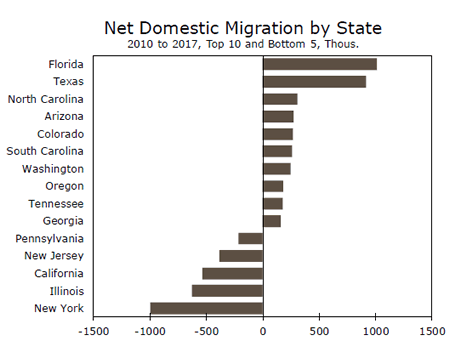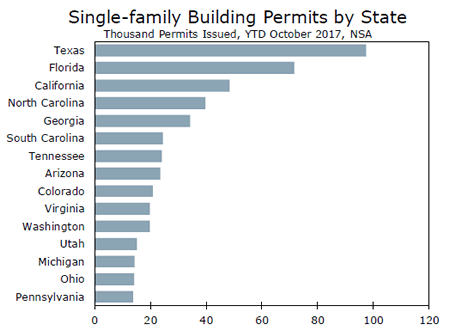U.S. Review
Economic Data Show Solid Momentum in Q4
- The three major housing market readings out this week were predominantly upbeat. Housing starts continued to point to a strong construction outlook. Existing home sales surged, although inventory tightened further. New home sales jumped to a fresh cycle-high.
- Household spending was strong in November, income registered a solid monthly increase and inflation perked up.
- Durable goods surged on volatile aircraft orders but revisions and underlying data pointed to solid momentum in core capital goods orders and shipments, which were up at 3-month average annualized rates of 18 percent and 14.9 percent, respectively.
Housing to End the Year with a Bang
Housing market conditions were largely positive in November and October, and forward-looking indicators suggest upbeat conditions will continue. The NAHB/Wells Fargo survey of homebuilder sentiment in December revealed optimism not seen since 1999. The strong report exceeded expectations, as the overall gauge rose five points on the month to a reading of 74. Details of the survey were also upbeat, as current sales and prospective buyer traffic were at their highest point since the late 1990s.
Homebuilders’ optimism for sales over the next six months is at its highest point of the current cycle. Homebuilders see continued income gains and low mortgage rates boosting demand, and also see policy changes in Washington as a plus to their industry. Builders specifically cited easier regulation and tax cuts.
Groundbreaking on single-family homes was running at its fastest seasonally adjusted pace of the current cycle in November. Some of the strength in the report was likely due to activity coming back to normal in the South after storm disruptions, but the year-todate comparisons were also strong, which suggests underlying momentum is also gaining. The warmer-than-usual weather in November also helped make last month a busier-than-usual month for building. Indeed, not seasonally adjusted starts declined less than they usually do in November. Combined with the sky-high optimism among builders, it appears single-family construction has perked up in recent months and is slated to continue to drive total construction in 2018. Apartment construction has largely topped out. Still, existing limitations on building remain, i.e. lot shortages and a tight supply of construction labor in many cities.
In step with other housing indicators this week, existing home sales were also at a cycle high in November. Resales surged well ahead of the 5.53-million unit pace expected by consensus to 5.81 million units, which is an 11-year high. This was the third monthly gain, and October’s pace was also revised up. There was broad strength regionally, as the West posted the only decline that was easily offset by a strong month of sales in the South and Midwest. Resales measure contract closings so they reflect contracts signed about two months ago; therefore some of the surge may be attributed to pent-up activity from extreme weather events in late August and early September. Moreover, seasonal adjustment factors are large during this time of year, so they may have exaggerated the effects of deviations from usual sales activity.
Even if some degree of the record-breaking surge was due to data volatility, it is also clear that underlying fundamentals in the housing market are strong. Strength in the job market continues to fuel housing demand, and mortgage rates are still quite low. That said, there are also supply headwinds that have not let up in recent months. Inventory of homes for sale declined 7.2 percent on the month, and there is now just a 3.4-month supply available. Cash purchases and investors also accounted for a larger share of resales in November, as first-time buyers run into affordability hurdles. Supply constraints and strong demand have pushed home prices higher and higher. Hopefully the optimism among homebuilders translates into better-priced new homes coming on the market.
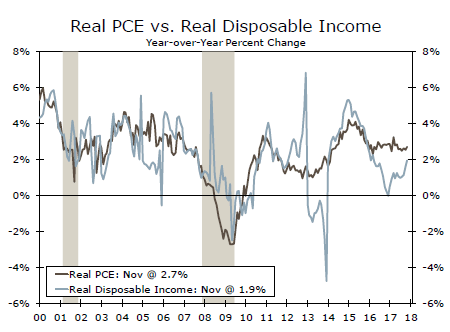
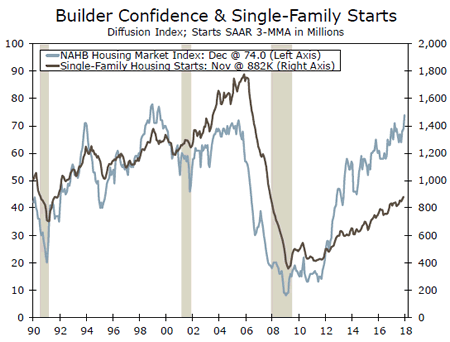
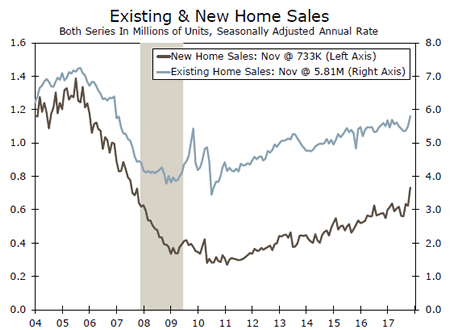
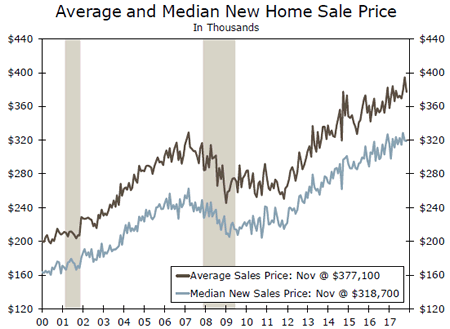
U.S. Outlook
ISM Manufacturing • January 3
The ISM manufacturing index slowed ever so slightly in November to 58.2 from 58.7. The composite index is coming off a cycle high of 60.8 in September, and with a six-month average of 58.4, the index continues to signal firmness in the manufacturing sector.
Subcomponent details are encouraging. The production index, for example, has been above 60 since June and came in at 63.9 in November; that’s the highest reading since March 2011.
As for employment, that index came in at 59.7, above its six-month average of 58.7. Industries reporting gains in employment include textile mills, machinery, computer products and paper. We anticipate that job gains in the first half of 2018 will be in line with the 2017 pace and thereby support continued consumer income and spending gains. We expect the December ISM manufacturing report to show a faint slowing to 58.0, while continuing to signal strength in the industry as a whole.
Previous: 58.2 Wells Fargo: 58.0 Consensus: 58.1
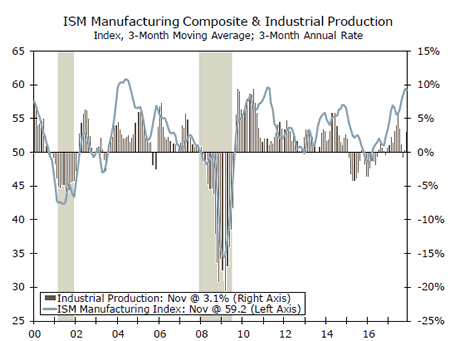
Trade Balance • January 5
The data in last month’s trade report for October are still being influenced by Hurricanes Harvey, Irma and Maria; these effects should blow away as we move farther away from the eye of the storm. Goods exports fell just more than $300 million and services exports increased $301 million for an overall increase of just $21 million —a drop in the bucket for the overall export figure of nearly $200 billion.
Imports posted the largest monthly gain since January. The surging imports, particularly in categories like consumer goods and autos, are consistent with our expectation that holiday sales will be strong this year and may reflect storekeepers and online vendors taking on stock in expectation of increased spending amid the highest levels of consumer confidence in more than 15 years. Looking forward, we forecast that the U.S. trade balance will widen modestly in the next two years.
Previous: -$48.7B Consensus: -$47.7B
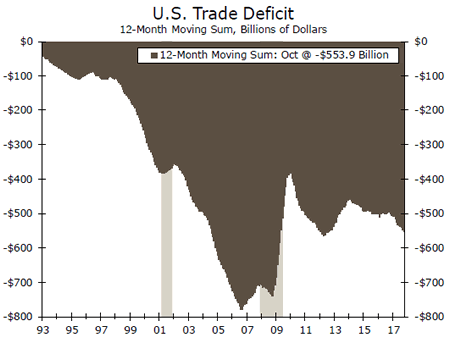
Nonfarm Employment • January 5
Nonfarm payrolls rose 228,000 in November, with the three-month average at 170,000 jobs. Job gains are consistent with 2.5-3.0 percent economic growth in the first half of 2018, with steady consumer spending, better business investment and a likely FOMC rate hike in Q1-2018. Jobs growth is strong in many sectors including business services, trade & transport as well as education & health.
Nominal average hourly earnings rose 0.2 percent in November, which was short of expectations. However, the average length of the work week edged up to 34.5 hours. Along with the net jobs added, this suggests income derived from the labor market has strengthened at a 4.7 percent annualized rate the past three months. Lackluster productivity growth in the current cycle has weighed on wage growth and will likely continue to hamper wage appreciation, even with low unemployment.
Previous: 228K Wells Fargo: 180K Consensus: 185K
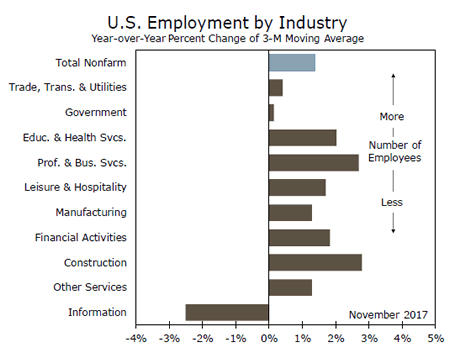
Global Review
Foreign Economic Growth Remains Resilient
- The Ifo index of German business sentiment remained near its all-time high in December. Although the Ifo index overstates the strength of Germany at present, economic growth generally remains solid.
- Real GDP in Canada was flat in October, but the underlying pace of growth continues to look solid. With unemployment at its second-lowest rate in more than 40 years, we look for the Bank of Canada to hike rates further in 2018.
- Growth in Brazil and Argentina, the two largest economies in South America, has strengthened in recent quarters.
German Economy Not as Strong as Ifo Index Suggests
If the Ifo index of German business sentiment is taken literally, then the German economy is absolutely booming at present. Data released this week showed that the headline index edged down a bit in December, but that it remained near the post-reunification high that it set in November.
Unfortunately, the "hard" data out of Germany are not quite as strong as the Ifo data would imply. Specifically, industrial production (IP) fell 1.4 percent on a monthly basis in October, which follows the 0.9 percent decline registered in September. Yes, German IP growth remains positive on a year-ago basis, but growth clearly has been stronger in previous cycles. More broadly, real GDP in Germany was up 2.8 percent in Q3-2017, the strongest year-over-year growth rate since the economy was exiting recession in 2010-2011. Most analysts expect that the German economy will continue to expand in coming quarters, but that the year-over-year rate of growth will slow somewhat.
Canadian Economy Remains Resilient Despite Disappointing GDP Outturn in October
Speaking of slowing, the Canadian economy continues to decelerate from the unsustainable 4 percent-plus pace that it registered earlier this year. Despite strong growth in retail spending in October—sales surged 1.5 percent in October relative to the previous month—real GDP was flat on the month, which was weaker than most analysts had expected (top chart). That said, real GDP is up 3.4 percent on a year-ago basis, so the Canadian economy is hardly coming apart at the seams. Meanwhile, the yearover- year rate of CPI inflation jumped from 1.4 percent in October to 2.1 percent in November, but it remained well within the Bank of Canada’s (BoC) target range of 1 percent to 3 percent.
Like most analysts, we look for the Canadian economy to decelerate a bit in the next two years from the 3 percent GDP growth rate that looks to have been registered in 2017. However, the low unemployment rate—it currently stands at 5.9 percent, its second-lowest rate in more than 40 years—means there probably is not much spare capacity left in the economy. Accordingly, we look for the BoC to hike rates twice in 2018, as it continues to remove policy accommodation.
Growth in South America Picking Up Again
This week’s economic data out of Brazil and Argentina suggest that South America’s two largest economies are picking up steam. In Argentina (the continent’s second-largest economy), real GDP growth strengthened from 2.9 percent in the second quarter to 4.2 percent in Q3, the strongest year-over-year growth rate in four years. In the continent’s largest economy, the Brazilian economic activity index, which is a good proxy for real GDP growth, rose to a 44-month high of 2.9 percent in October (bottom chart). Although we certainly do not expect growth in Brazil to return to pre-crisis rates anytime soon, we look for the Brazilian economy to strengthen further over the next two years.
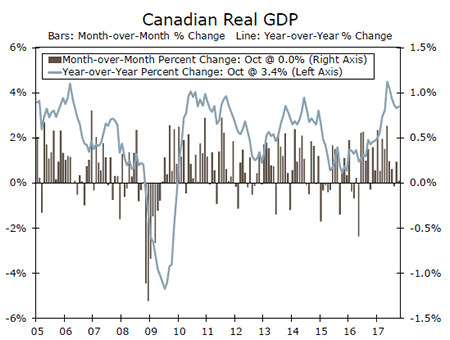
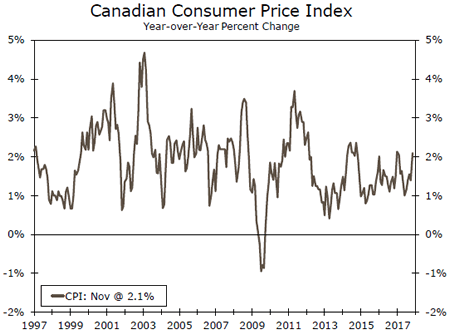
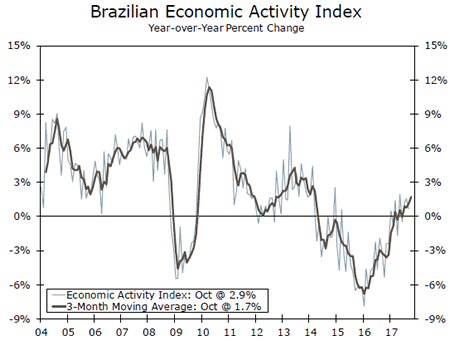
Global Outlook
Japanese CPI • December 25
A slew of economic data print in Japan next week, including retail sales, industrial production and the consumer price index. We have noted in previous publications that the Japanese economy is experiencing a spurt of economic momentum that, while modest by global standards, represents a marked improvement from the pace of growth seen in Japan much of this cycle. The Bank of Japan (BoJ), however, has kept its foot on the monetary policy accelerator, largely as a result of still stagnant inflation. As the chart to the right illustrates, core consumer prices are still hovering just above deflation territory, an omnipresent threat to the Japanese economy for much of the past two decades.
Solid industrial production and retail sales numbers would suggest the recent acceleration in GDP will continue into Q4, but it will take a more meaningful and sustained increase in inflation to convince the BoJ that a tighter stance on monetary policy is warranted.
Previous: 0.2% Wells Fargo: 0.3% Consensus: 0.5% (Year-over-Year)
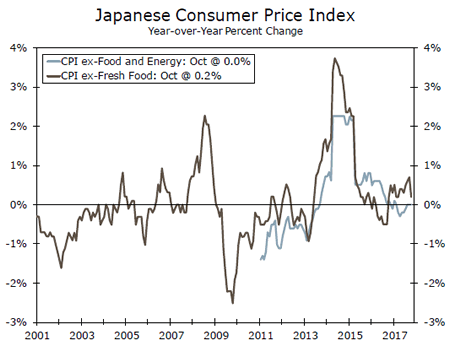
Brazilian Industrial Production • January 5
As we discussed in a recent special report, the Brazilian economy has continued to rebound, boosted by improvements in personal consumption and export growth. Third quarter data on the supply side of the Brazilian economy showed manufacturing output growing 2.4 percent on a year-earlier basis, the first positive reading for the manufacturing sector since Q1-2014. Even more encouraging, production in the factory sector in Q3 was up 1.4 percent sequentially and not annualized.
The cyclical rebound and strong global economy has benefitted Brazil, helping drive economic growth higher in the near-term. There are plenty of risks on the horizon, however, such as a presidential election cycle next year and a delicate fiscal situation. We will be watching the Q4 industrial production data for indications of just how much momentum the Brazilian economy will carry into 2018.
Previous: 5.3% (Year-over-Year)
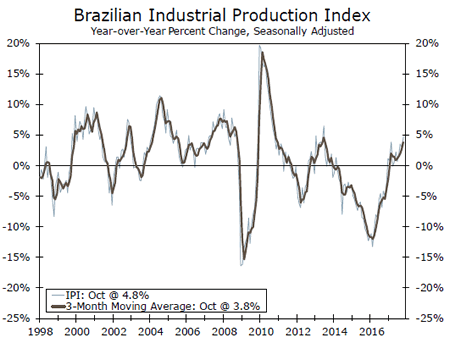
Canadian Employment • January 5
Canadian employment growth surged in November, as employers added more jobs than in any month since April 2012. Employment growth has been strong in 2017, helping support the 3 percent pace of real economic growth the Canadian economy has achieved on a year-ago basis.
Real private consumption growth in Canada was up 4 percent in Q3, the best pace of this expansion. The job gains through the first two months of Q4 suggest even more support to growth from the consumer sector. The downside, however, is that households have failed to make a meaningful dent in their debt burdens despite the robust labor market gains. The aggregate Canadian household debt-to-GDP ratio ticked higher in Q3 and is nearly 30 percentage points higher than in the United States. An accelerating economy and high household leverage continue to put the Bank of Canada in a challenging predicament.
Previous: 79.5K

Point of View
Interest Rate Watch
Tensions at the Turn
Inflation turns up. The Fed becomes more aggressive and shrinks the balance sheet. The dollar turns down. Economic growth picks up. The economic picture is turning and driving change in market interest rates.
Fundamentals are Turning for 2018
Since mid-2016, there has been a distinct upswing in benchmark Treasury rates (top graph). The first fundamental behind this turn has been the upswing in the PCE deflator to 1.7 percent from 1.2 percent in 2016. Over that same period, the employment cost index rose to 2.5 percent from 2.2 percent and the Brent front contract rose to $54.5 from $45.1 per barrel. For the year ahead, the PCE is expected to rise due to the unwinding of several one-off factors from 2017. In addition, we expect that labor costs and energy costs will continue to rise. Finally, we anticipate that stronger global growth and a weaker dollar will provide a boost to import prices as well.
As Inflation Goes, So Does the Fed
As inflation rises, and is expected to rise, so does the Fed. Two guideposts indicate upward pressure on our benchmark rate forecast. First, the dot-plot intimates that the Fed will pursue three increases in the Fed funds rate in 2018 and further increases in 2019. Investors in the two-year Treasury will have to discount these rises in the expected future funds rate. Our view is that the two-year rate will rise from 1.80 percent in the current quarter to 2.60 percent by the end of 2018.
A second guidepost is the Fed’s intended path to shrink its balance sheet in the years ahead (middle graph). We anticipate that the effect on the intermediate range of the Treasury yield curve (3 to 10 years) will start in mid-2018.
Dollar Weakness and Capital Flows
Our outlook is for the trade-weighted dollar (bottom graph) to weaken to 84.8 in Q4- 2018 from 89.3 in the current quarter. Expectations of a weaker dollar will incentivize foreign investors to seek a higher interest rate to compensate them for the exchange rate risk. There will likely also be a reduction of foreign capital flows into U.S. fixed income assets.
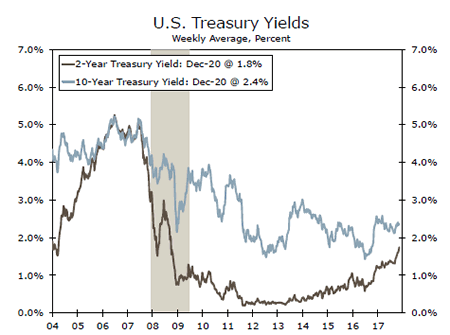
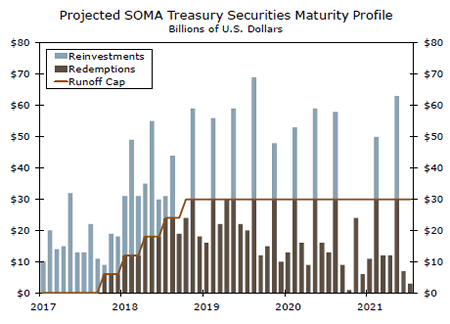
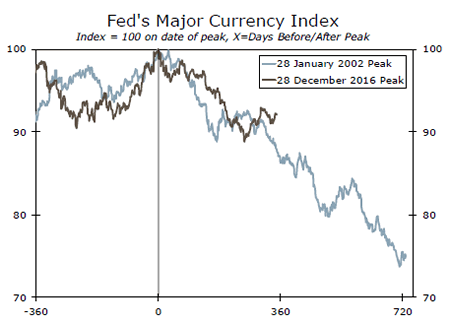
Credit Market Insights
Mortgage Lending Remains Low
The Federal Reserve’s Flow of Funds report for Q3-2017 was recently released. On the household side, the data showed improving net worth, strong appreciation of corporate equities and a lessening burden with respect to leverage and household liabilities. Bank lending activity, the report showed, continues to struggle to recover, particularly within residential mortgages and commercial real estate.
After an epic run of apartment construction, it appears commercial real estate loan demand has peaked. As of Q3, multifamily residential lending was reported by a net -18.1 percent of banks as having increased demand, with construction loans at -10 percent. Commercial real estate lending got an early start during this recovery, and this partially contributed to single-family housing’s slow recovery. This is reflected in the still low level of mortgage lending shown in the recent flow of funds data. As a percentage of total commercial bank assets, mortgages accounted for just 30.6 percent. This is slightly up from the recent all-time low, and down from the previous cycle high of 43.6 percent. Mortgages as a percent of assets seems to have bottomed out, displaying a slightly upward trend recently. With the apartment lending slowdown as multifamily construction seems to have peaked, combined with the positive momentum seen in housing demand and builder sentiment, we could see stronger mortgage lending growth on the horizon.
Topic of the Week
Tax Reform and Housing
Plenty of questions have arisen about the potential effects of tax reform on housing. Most center on the reduced limit of the mortgage interest deduction, which will fall to $750,000 from $1,000,000, and the $10,000 limitation on the deductibility of state and local taxes. These changes will fall disproportionately on high tax states, particularly those with lots of higher price homes. The standard deduction will also double for many households, so they will not receive any additional benefit from itemizing mortgage interest. Interest on home equity loans will also no longer be deductible.
Missing from this discussion is the upside of tax reform. Most tax payers will pay less in taxes and the reduction in corporate tax rates should unleash increased capital spending and stronger job growth. Our own forecast and the Federal Reserve’s forecast show stronger economic growth with the tax cuts. Real GDP grows faster in 2018 and the unemployment rate falls further. Stronger growth and increased job security will encourage homeownership. Still there will be distributional effects.
We see the changes in the tax law accelerating trends that are already in place. Residents have been leaving high cost and higher tax states for years and relocating to lower cost/lower tax states, principally in the Sunbelt. We see this trend accelerating. Within high cost states, demand will likely shift from higher priced markets, where mortgages are more likely to be above the new deductible cap, to more modest priced markets. We highlighted this trend in our recent report The Return of the Affordability Migration, published November 6.
The increase in the standard deduction may reduce some of the incentive for younger households to become homeowners. The shift of younger households to homeownership has been slow to materialize, however, as younger households continue to show a greater preference for mobility over tax breaks. If younger households delay homeownership further due to tax reform it might hurt the entry level home market somewhat but would help the apartment market.
